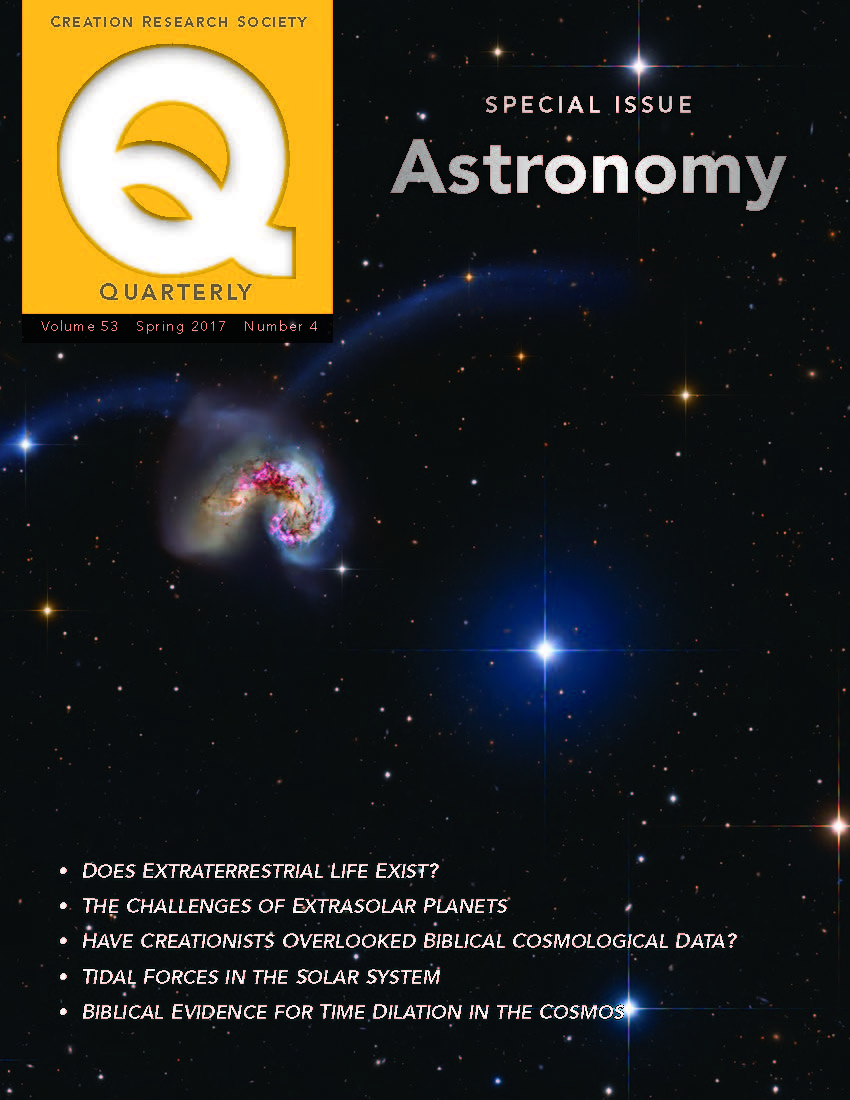Does Extraterrestrial Life Exist?
Danny R. Faulkner
Evolutionary models and biblical creation models make very different predictions about the likelihood of life, and especially intelligent life, elsewhere in the universe. Evolutionary models generally predict that life, and probably intelligent life, is relatively common in the universe, while creation models generally predict that we are alone in the universe. Three lines of evidence—the Fermi paradox, SETI, and the search for extrasolar planets—provide evidence to reach a conclusion on the matter. The evidence thus far greatly favors the creationary prediction and contradicts the evolutionary prediction.
FULL ARTICLE
Tidal Forces in the Solar System
Craig Davis
Tidal forces are a powerful factor in the development of the solar system. This paper summarizes various tidal effects and categorizes them as either direct or secondary, with secondary effects further categorized as strong or weak. Tidally induced heating, as well as the existence of Roche limits, are direct effects of tidal forces. The tidal acceleration effect, which pushes the moon away from Earth, and the tidal deceleration effect, which pulls the Martian satellite Phobos toward Mars, are weak secondary effects, because they depend on a secondary reaction to tides raised by the gravity of the smaller body on the larger body. The tidal locking/despinning effect, which tends to lock one face of a satellite to its planet, and the tidal circularization effect, which tends to produce circular orbits, are strong secondary effects, because they depend on a secondary reaction to tides raised by the gravity of the larger body on the smaller body. A quantification of some of these tidal forces is provided, and a comparative quantification of other tidal effects is made. Some tidal effects are problematic for an old solar system, while other tidal effects appear to place constraints on creation-based models of a young solar system. Further areas of study are suggested.
The Challenges of Extrasolar Planets
Wayne Spencer
Much has been learned about extrasolar planets in the past 20 years. An overview of the status of the research is presented, addressing exoplanet detection, planet formation and orbit migration, and issues that challenge current theories. Though the observational evidence of extrasolar planets is good in many cases, there are some difficulties in the analysis of the data and limitations of the methods. Extrasolar planetary systems often are very different from our own planetary system. Many known exoplanets are located closer to their stars than Mercury is to the sun. This has prompted development of theories for the migration of planet orbits. Migration theories have challenges in explaining why so many exoplanets have not spiraled into their star and have difficulty explaining exoplanets with orbits that are inclined compared to the equators of their stars. Recent reports from some researchers have expressed concerns that a surprising percentage of transit detections of exoplanets could be due to eclipsing binary stars or brown dwarf stars rather than exoplanets. Another challenge is the large radii of many so-called “hot Jupiters.” Known mechanisms may not be adequate to explain the sizes of these planets. Though there is much interest in finding evidence of habitable extrasolar planets, there is still no clear evidence that any exist. The meaning of “habitable zone” is discussed in relation to extrasolar planet research. Extrasolar planets can be understood as being created on the fourth day of the creation week rather than forming from protoplanetary disks.
Have Creationists Overlooked an Abundance of Biblical Cosmological Data?
Jake Hebert
Recently Faulkner has proposed that the “waters above” of Genesis 1:6–8 form a boundary beyond the farthest galaxies and that Genesis 1:1 is an introductory encapsulation of the events of Creation Week, rather than the first event in the sequence of God’s creative activities. I examine arguments for and against these views and attempt to derive additional cosmological implications from the former. I also examine several scriptural passages that may be cosmologically relevant but which seem to have gone overlooked by many commentators. For instance, the Bible may give us clues regarding the location of God’s abode, the large-scale spatial geometry of space, and hints as to whether our universe is expanding.
Biblical Evidence for Time Dilation in the Cosmos
D. Russell Humphreys
Several Scriptures imply that at the end of this age, presumably not long from now, distant stars will be much older than we see them now. The time required for most stars to get old is many billions of years, yet that much aging must occur within the roughly 6,000 years the Bible says have elapsed on Earth since Creation. Cosmologies using Einstein’s gravitational time dilation assert that clocks (and all physical processes) in the distant cosmos once ticked much faster than they did on Earth, so the above-mentioned Scriptures support those theories. But the Anisotropic Synchrony Convention (ASC) cosmology does not allow for time dilation, so the above-mentioned Scriptures are evidence against the ASC view.




